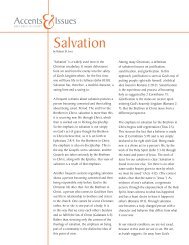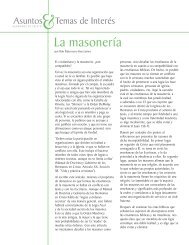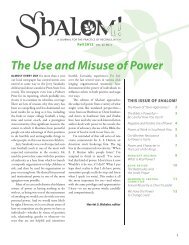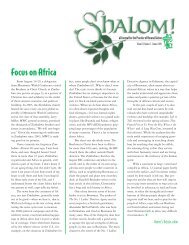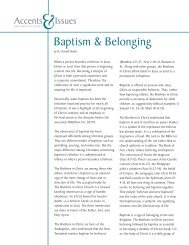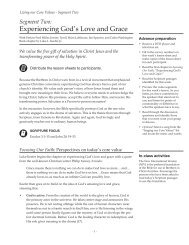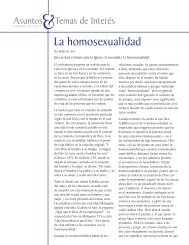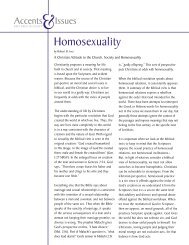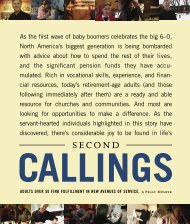Summer 2009 - Brethren in Christ Church
Summer 2009 - Brethren in Christ Church
Summer 2009 - Brethren in Christ Church
You also want an ePaper? Increase the reach of your titles
YUMPU automatically turns print PDFs into web optimized ePapers that Google loves.
One <strong>Christ</strong>ian to anothertold they are wrong, are more than happy to take theirbus<strong>in</strong>ess elsewhere. As one pastor recently told me, “It’shard to enact discipl<strong>in</strong>e when the church down the streetis happy to receive one more member.”The Old Order Amish and church discipl<strong>in</strong>eThere is, of course, one North American <strong>Church</strong> thatcont<strong>in</strong>ues to function <strong>in</strong> opposition to the religious marketplace.The Old Order Amish, who, as Anabaptists, sharetheological roots with the <strong>Brethren</strong> <strong>in</strong> <strong>Christ</strong> <strong>Church</strong>,function much more like a family than shoppers <strong>in</strong> a<strong>Christ</strong>ians, if they are to flourishspiritually, need people <strong>in</strong> theirlives who ask prob<strong>in</strong>g questionsand offer honest counsel.department store. Their local churches are small, and thepeople who attend them know each other well. It’s not unusualfor persons to be born <strong>in</strong>to, to receive baptism, andto live out their entire lives <strong>in</strong> a particular Amish congregation.S<strong>in</strong>ce Amish congregations are geographically based,Amish people aren’t allowed to transfer their membership.Choice may be the hallmark of consumer capitalism, but ithas not yet made its way <strong>in</strong>to the Amish <strong>Church</strong>.Whether you hold the Amish <strong>in</strong> high or low regard,it’s hard to deny the potency of Amish discipl<strong>in</strong>ary practices.This potency flows from four factors:1. The Amish have a clear set of shared standards, calledthe Ordnung. The Ordnung is not typically writtendown, but church members are keenly aware of itscontents and, at baptism, they vow to keep theseregulations for life.2. The Amish have a will<strong>in</strong>gness to enforce these standards.Although there may be exceptions, Amish churchleaders vigorously embrace the responsibility toenforce their district’s Ordnung. If the bishops don’tenforce the Ordnung, then the jig is up, and thecommunity will soon cease to be Amish.3. The Amish have a deep familiarity with their fellowchurch members. One of my friends who converted tothe Amish said the hardest part was not giv<strong>in</strong>g up hiscar, but rather his privacy. M<strong>in</strong>d<strong>in</strong>g one’s own bus<strong>in</strong>essmay be a virtue <strong>in</strong> some circles, but if you’re Amish,you’re supposed to m<strong>in</strong>d other people’s bus<strong>in</strong>ess.4. The Amish enact a form of discipl<strong>in</strong>e—shunn<strong>in</strong>g—thatis profoundly pa<strong>in</strong>ful to the wayward person. This ritualizedpractice of social distanc<strong>in</strong>g, which the Amishbase on I Cor<strong>in</strong>thians 5:9–13, varies from communityto community, but the goal is always the same: torestore the wayward person to the church. Shunn<strong>in</strong>gsometimes works, though its real power lies <strong>in</strong> thethreat of it, for it deters Amish people from establish<strong>in</strong>gtheir own set of rules for liv<strong>in</strong>g the <strong>Christ</strong>ian life.As far as I know, shunn<strong>in</strong>g has never been practiced <strong>in</strong>the <strong>Brethren</strong> <strong>in</strong> <strong>Christ</strong> <strong>Church</strong> (and I suspect most of usare grateful for that). But even if we leave shunn<strong>in</strong>g aside,I’m not conv<strong>in</strong>ced that contemporary <strong>Brethren</strong> <strong>in</strong> <strong>Christ</strong>churches demonstrate the other factors that make rigorousdiscipl<strong>in</strong>e possible <strong>in</strong> Amish communities. We may havea set of shared ethical standards, but that set is relativelym<strong>in</strong>imal; we don’t know our fellow church members verywell, especially if our churches are large; we tend not to putour noses <strong>in</strong>to “other people’s bus<strong>in</strong>ess”; and our churchleaders are often quite reluctant to enact discipl<strong>in</strong>e.But if traditional forms of church discipl<strong>in</strong>e requirethe sort of community that most North American<strong>Christ</strong>ians no longer <strong>in</strong>habit, what are we to do? Is selfdiscipl<strong>in</strong>eall we have left?Accountability as a complement to discipl<strong>in</strong>eGiven the perils <strong>in</strong>herent <strong>in</strong> this area, it’s tempt<strong>in</strong>g togive our full attention to the more impersonal (and oftenaffirmative) forms of <strong>Christ</strong>ian discipleship: preach<strong>in</strong>gand teach<strong>in</strong>g. These are crucial activities, and churchesand pastors are wise to devote their best efforts to them.Nonetheless, the New Testament assumes more personal,and at times confrontational, forms of correction.Consider Matthew 18, I Cor<strong>in</strong>thians 5, and Colossians3. These texts presume that the <strong>Church</strong> exists, at least <strong>in</strong>part, to correct those who go astray.IN PARTINPART.ORG



